
Categories
- TRANSMISSION-LINE
- Transmission-Line Fittings
- String Hardware
- Tower Attachment
- Parallel Groove Clamp
- Suspension Clamps
- Tension Clamps
- Compression Joint
- Repair Sleeve
- Preformed Armour Rod
- Stockbridge Damper
- Spacer & Spacer Damper
- Arcing Devices
- Counterweight & Jumper weight
- Danger plate & Number plate
- Corona & Grading Rings
- Transmission Conductor
- All aluminium stranded conductors(AAC)
- Aluminium conductors steel reinforced(ACSR)
- All aluminium alloy conductors(AAAC)
- Aluminium alloy conductors steel reinforced(AACSR)
- Arial Earth Wire & Shield Wire & Galvanized Steel Wire
- Porcelain Disc Suspension Insulators
- Composite Long Rod Insulators
- Toughened Glass Disc Insulator
- Tower of Transmission-Line
- SUBSTATION
- Connector and Fittings for Tubular Busbar
- Tubular Busbar Palm(Welding)
- Busbar A-Frame
- Connector for Tubular Busbar
- Tubular Busbar Support
- Tubular Busbar Earthing
- Tubular Busbar End Caps & Balls
- Substation Insulators
- Solid Porcelain Post Insulators(66kV -500kV)
- Solid Polymer Post Insulators(66kV-500kV)
- Hollow Core Insulators for Voltage Transformer
- Hollow Core Insulators for Capacitor
- Porcelain Disc Insualtors
- Polymer Long Rod Insulators
- Glass Disc Insulators
- Busbar
- Tubular Copper Busbar
- Rectangular Aluminum Busbar
- Rectangular Copper Busbar
- Tubular Aluminum Busbar
- Terminations & Connections for Conductor
- Aluminium Flexible Connector
- Copper Flexible Connector(Flat Braid)
- Compression Run Compression T Clamp(Closed)
- Compression Run Compression T Clamp(Open)
- Compression Run Palm Tap(Closed)
- Compression Run Palm Tap(Open)
- Compression Terminal Clamp
- Twin Conductor Compression Terminal Clamp
- Straight Bolted Type Terminal Clamp
- 90° Bolted Type Terminal Clamp
- Straight Twin Conductor Bolted Type Terminal Clamp
- 90° Twin Conductor Bolted Type Terminal Clamp
- Twin Conductor Bolted Type Tee Clamp
- Twin Conductor Run Palm Tap Lengthways Terminal Clamp
- Twin Conductor Run Palm Tap Transverse Terminal Clamp
- Parallel Groove Clamp
- Straight Connector Conductor to Conductor
- Tee Connector Conductor to Conductor
- Adaptor Plates
- Straight Type
- Right Angle Horizontal Type
- Right Angle Vertical Type
- Bi-Metallic Transition Plate
- Spacers
- Galvanized & Stainless Steel Bolts Assemblies
- Strings Fittings
- Connections for Flat Busbar
- Gantries & Structure
- Distribution Conductor
- All Aluminium Stranded Conductors(AAC)
- All Aluminium Alloy Conductors(AAAC)
- Substation Parallel Spacer Triple
- DISTRIBUTION
- Preformed Fittings
- Armor-Grip Suspension Clamp
- Trunnion Armor-Grip Clamp
- Aluminum Alloy Dead-Ends
- Copper Alloy Dead-End
- Thimbles
- Top Ties
- Armored Rod Twin Ties
- Side & Spool Ties
- Parrot Bill End Aluminum Alloy Armor Rods
- Copper Alloy Armor Rods
- Galvanized Steel Armor Rods
- Aluminium Alloy Line Splice
- Copper Alloy Line Splices
- Galvanized Steel Line Splices
- Aluminium Alloy Full Tension Line Splice
- T-Connector
- Helical Arcing Horn
- Galvanized Steel Guy-Grip
- Pole Top Make Off
- Insulated Stay
- Double-Wrap Guy-Grip
- Spiral Vibration Damper High Impact PVC
- Lashing Rods
- PVC Spacer
- The Pole Line Hardware
- Cross Arms
- Fastenes Bolts & Nuts
- Thimble Bolt Rod & Eye Bolt
- Eye Nuts
- Clevis
- Insulation Pin & Studs & Spindles
- Pole Hoop
- Cable & Conductor
- ACSR
- AAC
- ABC Cable
- SAC Cable
- Distribution Insulators
- Porcelain Disc Insualtors
- Polymer Long Rod Insulators
- Glass Disc Insulators
- Porcelain Line Post Insulators(Vertical)
- Porcelain Line Post Insulators(Horizontal)
- Polymer Line Post Insulators(Vertical)
- Polymer Line Post Insulators(Horizontal)
- Porcelain Pin Insulator(BS standard)
- Porcelain Pin Insulator(ANSI standard)
- Polymer Pin Insulators
- Shackle Insulators
- Spool Insulators
- Stay Insulators
- Wiring Insulators
- Telephone Lines Insulators
- Guy Strain Insulators
- Spindle for insulators
- BS Spindle for Pin Insulators
- ANSI Spindle for Pin Insulators
- Normal Short Spindle for Line Post Insulators
- Rachet short spindle for line post insulators
- Rachet long spindle for line post insulators
- Fuse/fuse cutout
- Porcelain Fuse Cutout
- Composite Fuse Cutout
- K Type Fuse Link
- HRC Fuse
- J Type Fuse
- Disconnect Switch
- Surge Arrestor 11-36kV(5kA-10kA)
- Over head Line fittings
- Suspension Clamp
- Bolt Type Tensioning Clamp
- U-Bolts
- Shackle
- Ball Eye
- Socket Tongue
- Arcing Horn
- UT Connectors
- ABC fittings
- Copper Strand Wire and Braid Connector
- Insulation Piercing Connector(IPC)
- Fire-Retardant IPC
- T connecting Terminal
- Insulation Piercing Grounding Connectors
- Fuse Bace
- Wedged Insulation Strain Clamp
- Suspension Clamp for ABC cable
- Suspension Clamp with Aluminum Bracket
- Anchoring Clamp
- Metal Anchor Clamp
- Four-Core Tension Clamp
- Pre-Insulated Sleeve
- Pre-Insulated Bimetal Sleave
- Expansion Screws
- JXL Series Clamp(Wedge Type)
- Parallel Groove Clamp with Insulator Cover
- SAC fittings
- Anti Sway Bracket for HDPE Spacer
- Tangent Support Bracket
- HT Tape for SAC Cable
- Cable lug
- Copper Cable Lugs-DT
- Double Holes Copper Cable lugs-DT2
- Aluminum Cable Lugs-DL
- Double holes Aluminum Cable lugs-DL2
- Bi-Metal Cable Lugs-DTL
- Copper Aluminum Cable lugs-CAL-A
- Copper Aluminum Cable lugs-CAL-B
- Copper Aluminum Cable lugs-European style
- Copper Aluminum Cable lugs-For cable tap box
- Copper Cable Lugs-OT
- P.G. Clamp & Connector
- Copper Parallel Groove Clamp-CAPG
- Aluminum Parallel Groove Clamp-CAPG
- Copper Parallel Groove Clamp
- Aluminum Parallel Groove Clamp-JB
- Copper-Aluminum Parallel Groove Clamp-CAPG(Hard-Solder)
- Copper-Aluminum Parallel Groove Clamp-CAPG( Friction Welding)
- C Clamp-Copper
- C Clamp-Aluminum
- Connecting Clamp-Aluminum
- Connecting Clamp-Copper
- Connecting Clamp (Hard-Solder)
- Connecting Clamp (Friction Welding)
- Connecting Tube-Aluminum
- Connecting Tube-Copper
- Connecting Tube-Bimetal
- Copper Plate
- Aluminum Plate
- Bimetal Plate
- Copper-Aluminum Parallel Groove Clamp( Friction Welding)
- Stay complete set
- Eye Bolts
- Turn Buckle
- Thimble
- Stay Grip
- Stay Wire
- Adjustable Stay Rod
- Non Adjustable Stay Rod
- Stay Anchor Plate/Earth Plate
- Other accessory
- Stainless Steel with Retaining Buckle
- Cable Nail
- Insulation Tape
- Stainless Steel Strip
- Aluminium Insulated Tie Wire
- COMMUNICATION
- Dead-End for OPGW
- Single Suspension Set
- Double Suspension Set
- Vibration Damper
- Armour Rods for Vibration Damper
- Ground Wire Set
- Joint Box
- Cable Tray
- Spiral Vibration Damper
- Corona Coil
- Downlead
- Downlead
- Fastened Fittings for Pole
- Fastened Fittings for Pole
- Fastened Fittings for Twoer
- Fastened Fittings for Twoer
- Fastened Fittings for Twoer
- GROUNDING SYSTEM
- Earth Rod
- Solid Stainless Steel Earth Rods
- Solid Copper Earth Rods
- Copper Clad Steel Earth Rods
- H.D.G Steel Earth Rods
- Earthing Wire
- Copper Wire
- PVC Covered Copper Wire
- Flexible Copper Braid
- Copper Clad Steel Wire
- Fittings for Earth Rod
- Fittings for Threaded Earth Rod
- Fittings for Unthreaded Earth Rods
- Earth Tube
- Conductor Tape
- Copper Tape
- Tinned Copper Tape
- PVC Insulated Copper Tape
- Stainless Steel Tape
- Aluminum Tape
- Bentonite
- Concrete Earth Pits
- Connectors
- C connectors
- Tinned Copper Flexible Connector
- Tape Clip
- Tape Clamp
- Rod to Tape Clamp
- Rod to Cable Clamp
- U-Bolt Rod Clamp
- Earth Points
- Earth Plates
- Solid Copper Earth Plates
- Lattice Copper Earth Plates
- Earth Bars & Disconnector Links
- Exothermic Welding
- Exothermic Powder
- Tooling Box
- Exothermic Welding Mould
- Marconite
- INSULATOR FITTINGS
- Clevis Fittings
- Y-Clevis Fittings
- Tongue Fittings
- Socket Fittings
- Ball Fittings
- Eye Fittings
- For Line Post Insulator
- For Cross-Arm Composite Insulator
- For Pin Insulator
- For Railway Insulator
- For Clamp (Vertical)
- For Clamp (Horizontal)
- Ball Pin & Socket Cap
- Tongue Pin & Clevis Cap
- For Others
- Top Head Fitting for Line Post Insulator
- Top Head Fitting Clevis for Line Post Insulator
- Top Head fitting Tongue for Line Post Insulator
- POWER CONSTRUCTION TOOLS
- Galvanized Steel Antitwist Wire Rope
- Hydraulic Press
- Hand Hydraulic Crimping Tools
- Cable Cutter
- Tube Terminal Crimping Tools
- Mechanical Cable Cutter
- Wire Grip
- Hand Puller
- Snactch Block
- Stringing Block
- Cable Wellhead Pulley
- Cable Orifice Protection Pulleys
- High Voltage Operating Rod/Hot Stick
- H.V. Earthing Wire and Rod
- Security Clamp
- Wood Pole Climber
- Grounding Clamp
- Hot Line Cable Clamp
- Swivel Joints
- Elelctro Scope
- OEM/ODM
- SOLAR

P.G. Clamp & Connector
P.G. Clamp & Connector
-
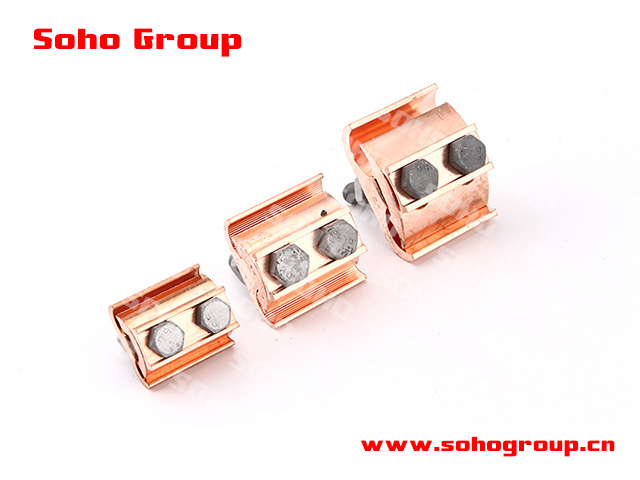 Copper Parallel Groove Clamp-CAPG
Copper Parallel Groove Clamp-CAPG● Application: CAPGs are commonly used in power distribution systems, such as those found on utility poles, substations, or other electrical infrastructure, to connect and support copper conductors.
● Parallel Grooves: The key feature of these clamps is their parallel groove design, which securely holds and supports copper conductors. The parallel grooves ensure proper alignment and contact with the conductor.
● Materials: CAPGs are typically made of high-conductivity copper to maintain electrical conductivity and mechanical strength.
● Weatherproofing: Many CAPGs are designed to be weatherproof and resistant to environmental factors, ensuring long-term reliability in outdoor environments.
-
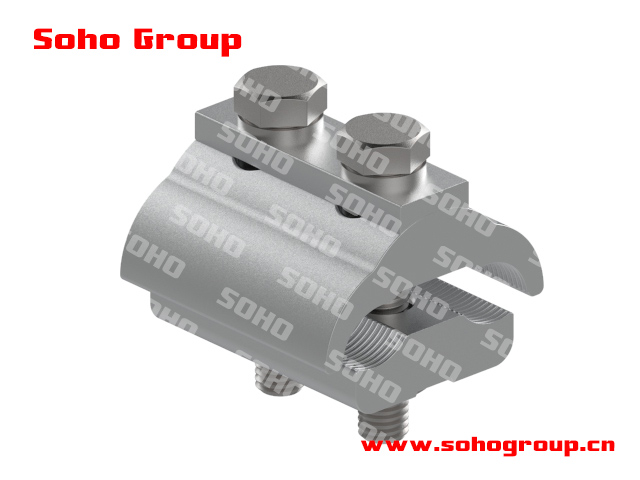 Aluminum Parallel Groove Clamp-CAPG
Aluminum Parallel Groove Clamp-CAPG● Application: Aluminum CAPGs are commonly used in overhead power distribution systems, such as those found on utility poles, substations, or other electrical infrastructure, to connect and support aluminum conductors.
● Parallel Grooves: The key feature of these clamps is their parallel groove design, which securely holds and supports aluminum conductors. The parallel grooves ensure proper alignment and contact with the conductor.
● Materials: CAPGs are typically made of aluminum or aluminum alloy, which is lightweight and corrosion-resistant, making them suitable for outdoor applications.
● Weatherproofing: Many Aluminum CAPGs are designed to be weatherproof and resistant to environmental factors, ensuring long-term reliability in outdoor environments.
-
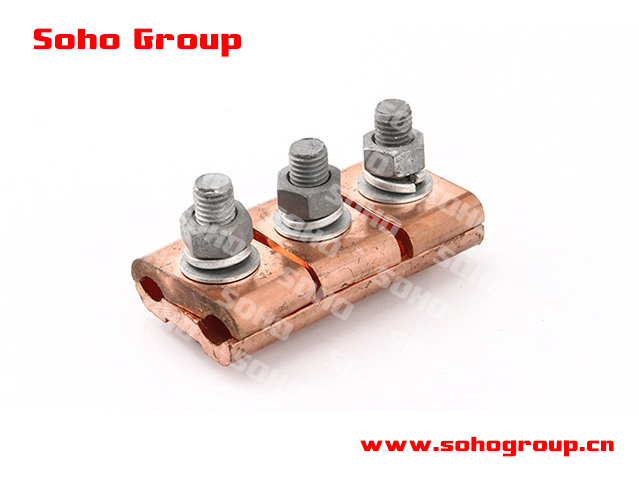 Copper Parallel Groove Clamp
Copper Parallel Groove Clamp● Application: Copper Parallel Groove Clamps are commonly used in power distribution systems, such as those found on utility poles, substations, or other electrical infrastructure. They are used to connect and support copper conductors.
● Parallel Grooves: The key feature of these clamps is their parallel groove design. These grooves securely hold and support copper conductors, ensuring proper alignment and contact.
● Materials: Copper PG Clamps are typically made of high-conductivity copper or copper alloy to maintain excellent electrical conductivity and mechanical strength.
● Weatherproofing: Many PG Clamps are designed to be weatherproof and resistant to environmental factors, ensuring long-term reliability in outdoor environments.
-
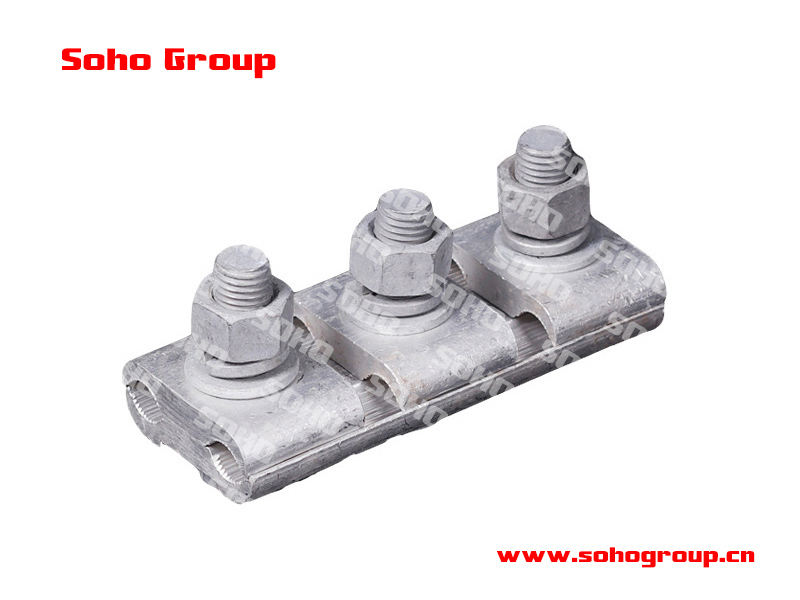 Aluminum Parallel Groove Clamp-JB
Aluminum Parallel Groove Clamp-JB● Application: Aluminum Parallel Groove Clamps are commonly used in overhead power distribution systems, such as those found on utility poles, substations, or other electrical infrastructure. They are used to connect and support aluminum conductors.
● Parallel Grooves: These clamps have a parallel groove design that securely holds and supports aluminum conductors, ensuring proper alignment and contact.
● Materials: Aluminum PG Clamps are typically made of aluminum or aluminum alloy. Aluminum is chosen for its lightweight properties and corrosion resistance, making it suitable for outdoor applications.
● Weatherproofing: Many PG Clamps are designed to be weatherproof and resistant to environmental factors, ensuring long-term reliability in outdoor environments.
-
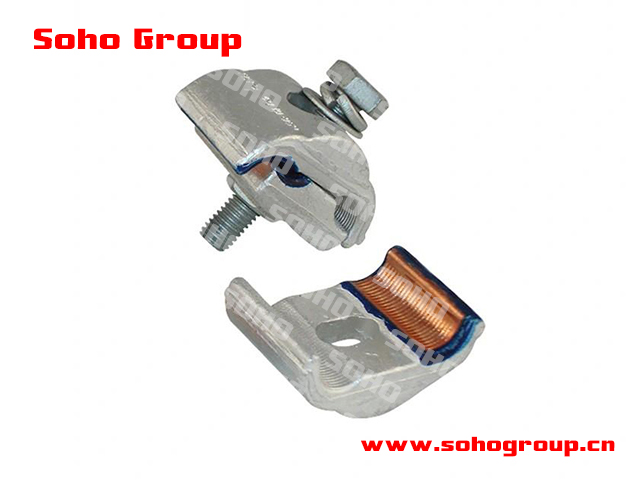 Copper-Aluminum Parallel Groove Clamp-CAPG(Hard-Solder)
Copper-Aluminum Parallel Groove Clamp-CAPG(Hard-Solder)● Application: Copper-Aluminum Parallel Groove Clamps (CAPG) are used in power distribution systems, particularly in applications where a transition between copper and aluminum conductors is required. These clamps facilitate secure connections between dissimilar metals.
● Parallel Grooves: The clamps feature a parallel groove design that securely holds and supports both copper and aluminum conductors, ensuring proper alignment and contact.
● Materials: CAPGs are typically constructed using a combination of copper for the copper conductor connection and aluminum or aluminum alloy for the aluminum conductor connection. This construction is designed to accommodate the dissimilarity of the materials.
● Hard-Solder Connection: The "Hard-Solder" designation implies that a hard soldering process is used to create a durable and reliable connection between the copper and aluminum parts of the clamp. Soldering ensures good electrical conductivity and mechanical integrity.
● Weatherproofing: Many CAPGs are designed to be weatherproof and resistant to environmental factors, ensuring long-term reliability, especially in outdoor environments.
-
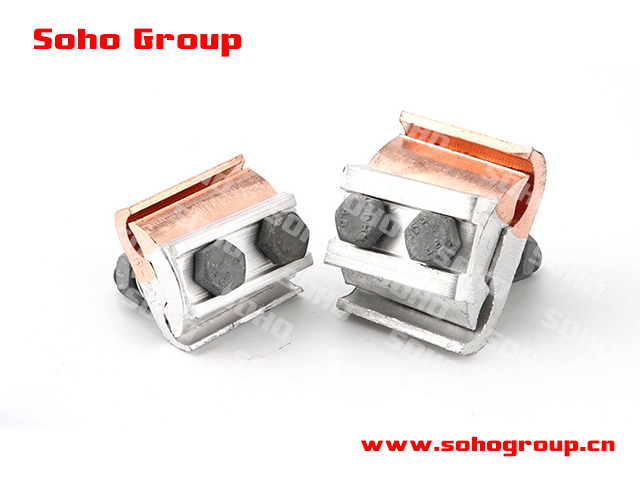 Copper-Aluminum Parallel Groove Clamp-CAPG( Friction Welding)
Copper-Aluminum Parallel Groove Clamp-CAPG( Friction Welding)● Application: Copper-Aluminum Parallel Groove Clamps (CAPG) are used in power distribution systems, especially in applications where a transition between copper and aluminum conductors is required. These clamps enable secure connections between dissimilar metals.
● Parallel Grooves: The clamps feature a parallel groove design that securely holds and supports both copper and aluminum conductors, ensuring proper alignment and contact.
● Materials: CAPGs are typically constructed using a combination of copper for the copper conductor connection and aluminum or aluminum alloy for the aluminum conductor connection. This construction is designed to accommodate the dissimilarity of the materials.
● Friction Welding Connection: The "friction welding" designation implies that friction welding is used to create a durable and reliable connection between the copper and aluminum parts of the clamp. Friction welding is a solid-state welding process that can provide a strong and high-quality bond without the use of filler material or brazing.
● Weatherproofing: Many CAPGs are designed to be weatherproof and resistant to environmental factors, ensuring long-term reliability, particularly in outdoor environments.
-
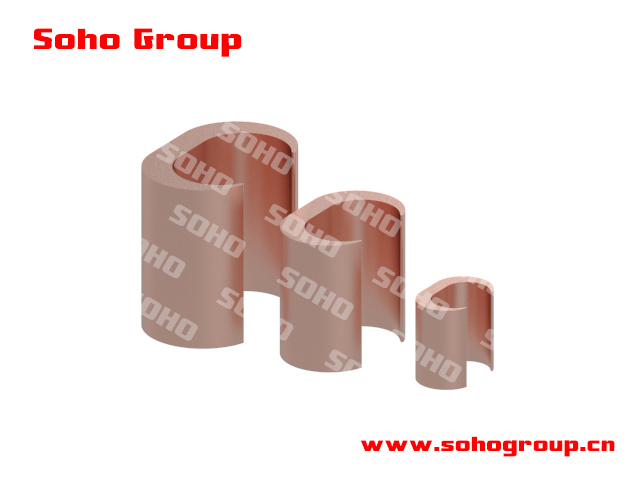 C Clamp-Copper
C Clamp-Copper● Application: Copper C Clamps are commonly used in power distribution systems, including those found on utility poles, substations, or other electrical infrastructure. They serve to connect and support copper conductors.
● Materials: Copper C Clamps are typically made from high-conductivity copper or copper alloy. The use of copper ensures excellent electrical conductivity and mechanical strength.
● Design: C Clamps are named for their "C" shape, which allows them to encircle or "clamp" around the copper conductors. This design securely holds the conductors in place.
● Weatherproofing: Many Copper C Clamps are designed to be weatherproof and resistant to environmental factors, ensuring long-term reliability in outdoor environments.
-
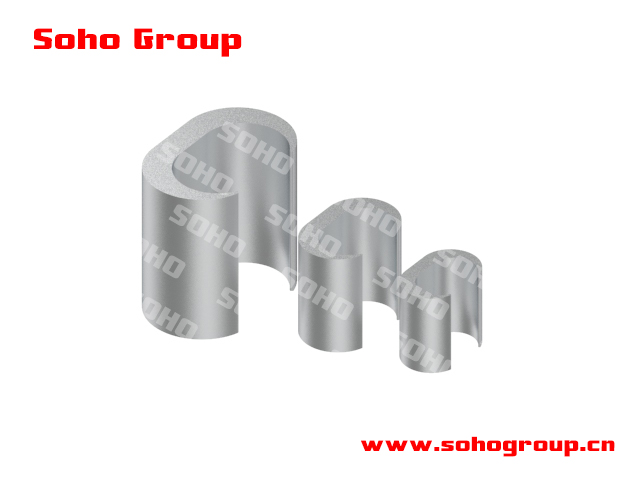 C Clamp-Aluminum
C Clamp-Aluminum● Application: Aluminum C Clamps are commonly used in power distribution systems, including those found on utility poles, substations, or other electrical infrastructure. They serve to connect and support aluminum conductors.
● Materials: Aluminum C Clamps are typically made from aluminum or aluminum alloy. Aluminum is chosen for its lightweight properties and corrosion resistance, making it suitable for outdoor applications.
● Design: C Clamps are named for their "C" shape, which allows them to encircle or "clamp" around the aluminum conductors. This design securely holds the conductors in place.
● Weatherproofing: Many Aluminum C Clamps are designed to be weatherproof and resistant to environmental factors, ensuring long-term reliability in outdoor environments.
-
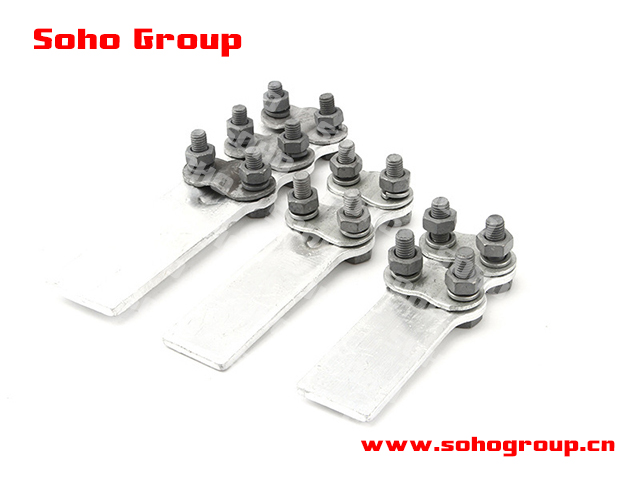 Connecting Clamp-Aluminum
Connecting Clamp-Aluminum● Application: Aluminum Connecting Clamps are commonly used in power distribution systems, substations, and electrical infrastructure, where connections between aluminum conductors and other electrical components are required.
● Materials: These clamps are typically constructed using aluminum or aluminum alloy. Aluminum is chosen for its lightweight properties and resistance to corrosion, making it suitable for outdoor and exposed environments.
● Design: Connecting clamps are designed to securely hold and connect aluminum conductors to other components. They may have a design that allows for easy attachment and secure fastening.
● Weatherproofing: Many aluminum connecting clamps are designed to be weatherproof, ensuring that they can withstand exposure to environmental factors and provide long-term reliability.
-
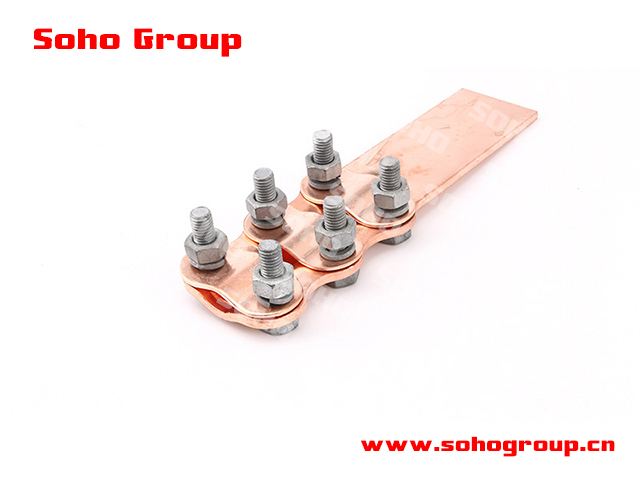 Connecting Clamp-Copper
Connecting Clamp-Copper● Application: Copper Connecting Clamps are commonly used in power distribution systems, substations, and electrical infrastructure where connections between copper conductors and other electrical components are required.
● Materials: These clamps are typically constructed using high-conductivity copper or copper alloy. Copper is chosen for its excellent electrical conductivity and mechanical strength.
● Design: Connecting clamps are designed to securely hold and connect copper conductors to other components. They may have a design that allows for easy attachment and secure fastening.
● Weatherproofing: Many copper connecting clamps are designed to be weatherproof, ensuring that they can withstand exposure to environmental factors and provide long-term reliability.
-
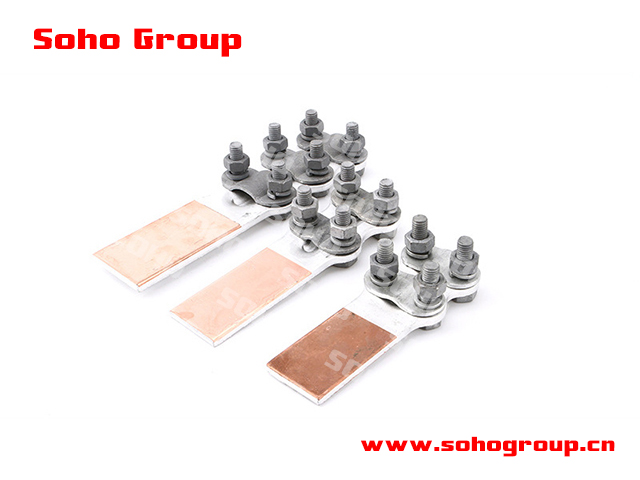 Connecting Clamp (Hard-Solder)
Connecting Clamp (Hard-Solder)● Application: Connecting Clamps with "Hard-Solder" can be used in a variety of electrical and power distribution applications, including those found on utility poles, substations, and electrical infrastructure.
● Materials: These clamps are constructed using materials suitable for electrical conductivity and soldering. The materials may include copper, aluminum, or other conductive materials.
● Hard-Solder Connection: The "Hard-Solder" designation implies that a hard soldering process is used to create a durable and reliable connection between the clamp and the conductor. Soldering ensures a secure and electrically conductive bond.
● Design:: Connecting clamps with "Hard-Solder" can have different designs, depending on the specific application and requirements. They are designed for easy attachment and secure fastening.
-
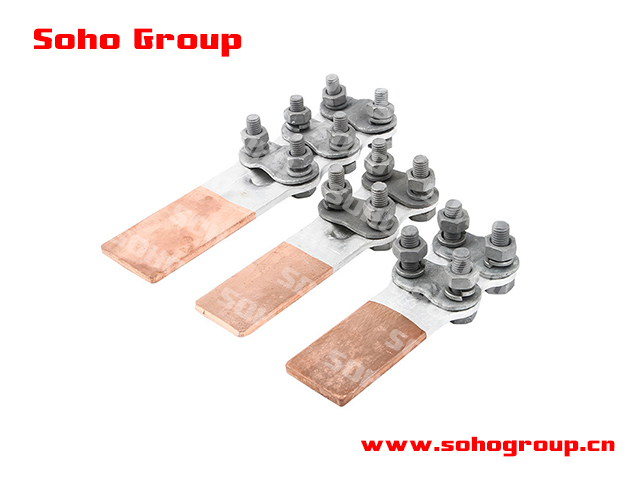 Connecting Clamp (Friction Welding)
Connecting Clamp (Friction Welding)● Application: Connecting Clamps with "Friction Welding" can be used in various electrical and power distribution applications, including those found on utility poles, substations, and electrical infrastructure.
● Materials: These clamps are constructed using materials suitable for friction welding and electrical conductivity. The materials may include copper, aluminum, or other conductive materials.
● Friction Welding Connection: The "Friction Welding" designation implies that friction welding is used to create a durable and reliable connection between the clamp and the conductor. Friction welding is a solid-state welding process that can provide a strong and high-quality bond without the use of filler material or brazing.
● Design: Connecting clamps with "Friction Welding" can have different designs, depending on the specific application and requirements. They are designed for easy attachment and secure fastening.
-
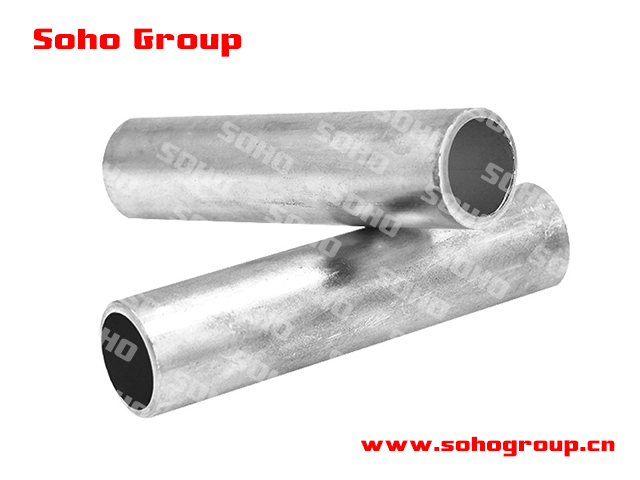 Connecting Tube-Aluminum
Connecting Tube-Aluminum● Application: Aluminum Connecting Tubes are commonly used in power distribution systems, including those found on utility poles, substations, or other electrical infrastructure. They serve to connect and support aluminum conductors.
● Materials: These tubes are typically constructed using aluminum or aluminum alloy. Aluminum is chosen for its lightweight properties and corrosion resistance, making it suitable for outdoor and exposed environments.
● Design: Connecting tubes are designed to securely enclose and connect aluminum conductors, ensuring proper alignment and electrical contact.
● Weatherproofing: Many aluminum connecting tubes are designed to be weatherproof and resistant to environmental factors, ensuring long-term reliability.
-
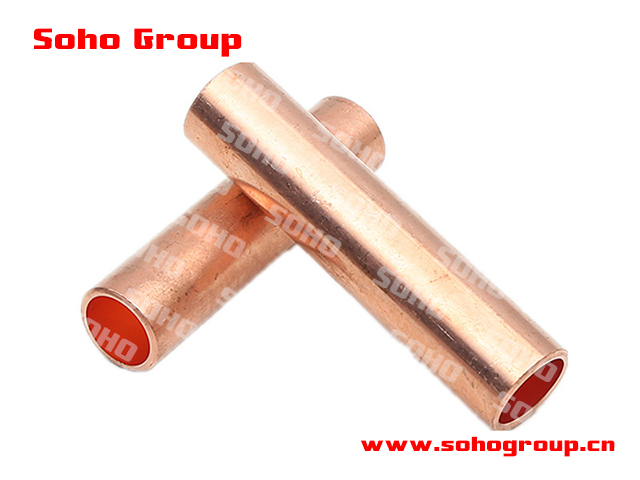 Connecting Tube-Copper
Connecting Tube-Copper● Application: Copper Connecting Tubes are commonly used in power distribution systems, including those found on utility poles, substations, or other electrical infrastructure. They serve to connect and support copper conductors.
● Materials: These tubes are typically constructed using high-conductivity copper or copper alloy. Copper is chosen for its excellent electrical conductivity and mechanical strength.
● Design: Connecting tubes are designed to securely enclose and connect copper conductors, ensuring proper alignment and electrical contact.
● Weatherproofing: Many copper connecting tubes are designed to be weatherproof and resistant to environmental factors, ensuring long-term reliability.
-
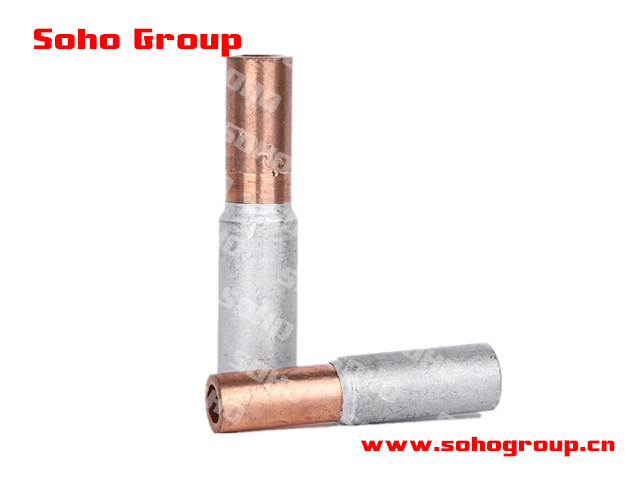 Connecting Tube-Bimetal
Connecting Tube-Bimetal● Application: Bimetal Connecting Tubes are commonly used in power distribution systems, particularly in applications where a transition between copper and aluminum conductors is required. These tubes facilitate secure connections between dissimilar metals.
● Materials: Bimetal connecting tubes are constructed using two different materials, typically copper for one part and aluminum for the other. Copper is chosen for its excellent electrical conductivity, while aluminum is lightweight and corrosion-resistant.
● Design: Bimetal connecting tubes are designed to securely enclose and connect the copper and aluminum conductors, ensuring proper alignment and electrical contact.
● Weatherproofing: Many bimetal connecting tubes are designed to be weatherproof and resistant to environmental factors, ensuring long-term reliability, especially in outdoor environments.
-
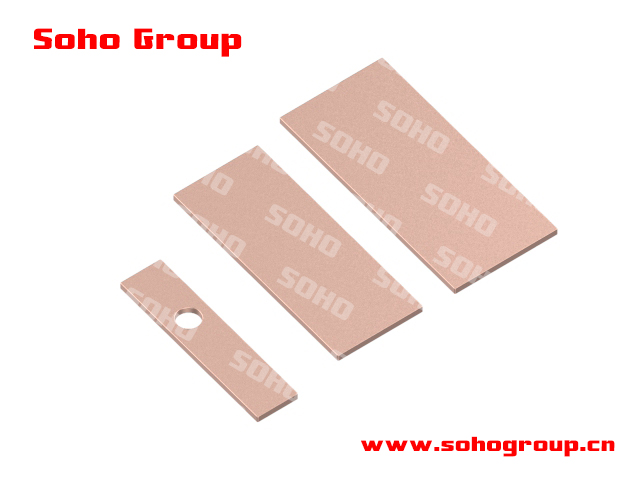 Copper Plate
Copper Plate● Busbars: Copper plates are often used to create busbars in electrical switchgear, distribution boards, and power substations. Busbars are essential for carrying and distributing electrical power within the equipment.
● Circuit Breakers: Copper plates may be used in circuit breakers as contacts and current-carrying components. Copper's conductivity ensures efficient current interruption and flow control.
● Transformers: Copper plates can be used in the windings of transformers, as they offer excellent conductivity for transmitting electrical energy between coils.
● Electrical Panels: Copper plates are used in electrical panels for grounding, bonding, and providing a conductive surface for the installation of electrical components.
● Electrical Contacts: In various electrical devices and switches, copper plates are used as contacts to establish and break electrical circuits. The high conductivity of copper ensures low resistance and efficient electrical connections.
-
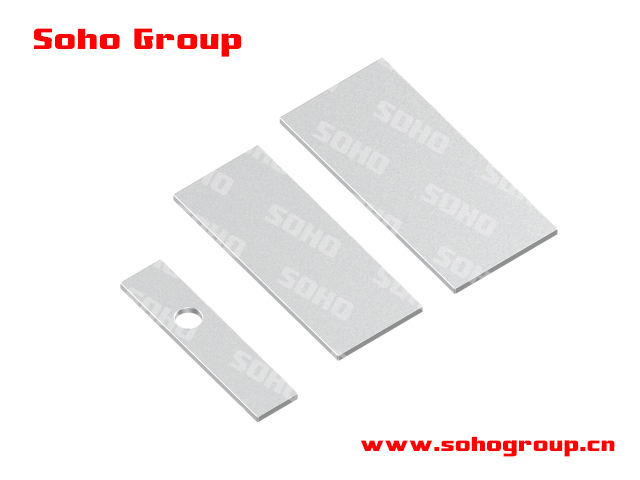 Aluminum Plate
Aluminum Plate● Busbars: Aluminum plates are often used to create busbars in electrical switchgear, distribution boards, and power substations. Busbars are essential for carrying and distributing electrical power within the equipment.
● Circuit Breakers: Aluminum plates may be used in circuit breakers as contacts and current-carrying components. Aluminum's conductivity ensures efficient current interruption and flow control.
● Transformers: In some cases, aluminum plates are used in the windings of transformers, especially in applications where weight reduction is a significant consideration. Aluminum is lighter than copper but still offers good electrical conductivity.
● Electrical Panels: Aluminum plates are used in electrical panels for grounding, bonding, and providing a conductive surface for the installation of electrical components.
-
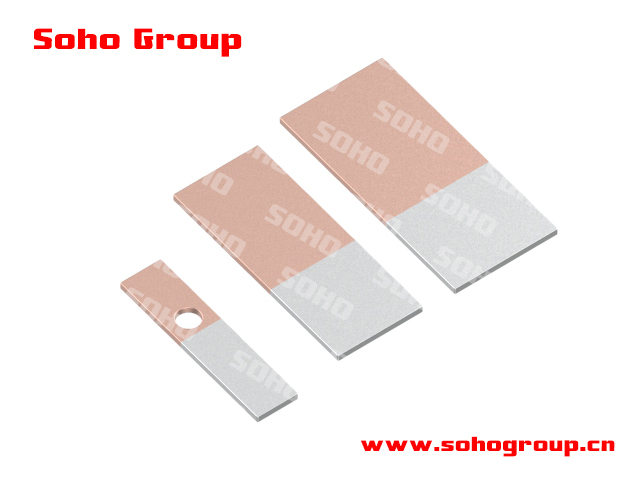 Bimetal Plate
Bimetal Plate● Circuit Breakers: Bimetal plates are used in the construction of bimetallic elements for thermal overload protection in circuit breakers. These elements respond to changes in temperature and provide a mechanism for tripping the circuit breaker when excessive heat is generated.
● Thermostats: In thermostats, bimetal plates are used to control temperature and regulate the operation of heating or cooling systems. When the temperature changes, the bimetallic element bends or warps, which activates or deactivates the thermostat.
● Temperature Sensors: Bimetal plates are used in temperature sensors to measure temperature changes accurately. As the temperature changes, the bimetallic strip bends or expands, creating a measurable response.
● Electrical Contacts: Bimetal plates are used as contacts in various electrical devices and switches. The differential expansion and contraction of the two metals allow for precise control of electrical circuits.
● Overload Relays: Bimetal plates are utilized in overload relays, where they provide protection against motor overloads by tripping the relay when the bimetallic element warps due to excess current.
-
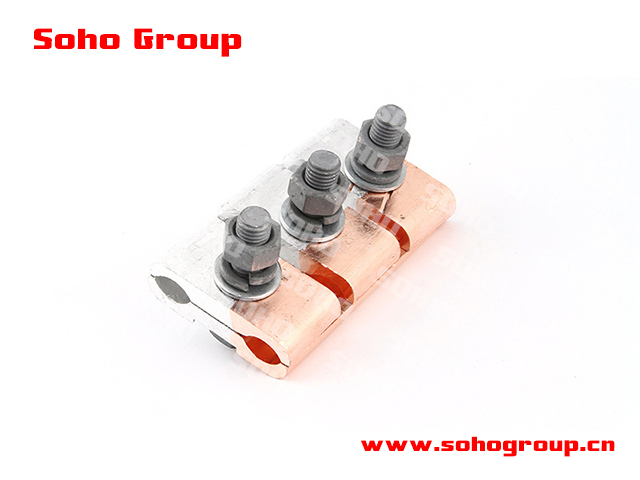 Copper-Aluminum Parallel Groove Clamp( Friction Welding)
Copper-Aluminum Parallel Groove Clamp( Friction Welding)● Application: Copper-Aluminum Parallel Groove Clamps with "Friction Welding" are used in power distribution systems where a transition between copper and aluminum conductors is required. These clamps facilitate secure connections between dissimilar metals.
● Materials: These clamps are constructed using a combination of copper for the copper conductor connection and aluminum for the aluminum conductor connection. This construction is designed to accommodate the dissimilarity of the materials.
● Friction Welding Connection: The "Friction Welding" designation implies that friction welding is used to create a durable and reliable connection between the copper and aluminum components. Friction welding is a solid-state welding process that can provide a strong and high-quality bond without the use of filler material or brazing.
● Design: Copper-Aluminum Parallel Groove Clamps are designed with parallel grooves that securely hold both copper and aluminum conductors, ensuring proper alignment and electrical contact.
● Weatherproofing: Many CAPGs are designed to be weatherproof and resistant to environmental factors, ensuring long-term reliability, particularly in outdoor environments.
Sorry, no matches were found in Products for P.G. Clamp & Connector.
Want to get the matched products and detailed quotations?







 +86-25-58065309
+86-25-58065309
 www.sohogroup.cn
www.sohogroup.cn Daqiao Industry Park, Yangzhou City,
Daqiao Industry Park, Yangzhou City,